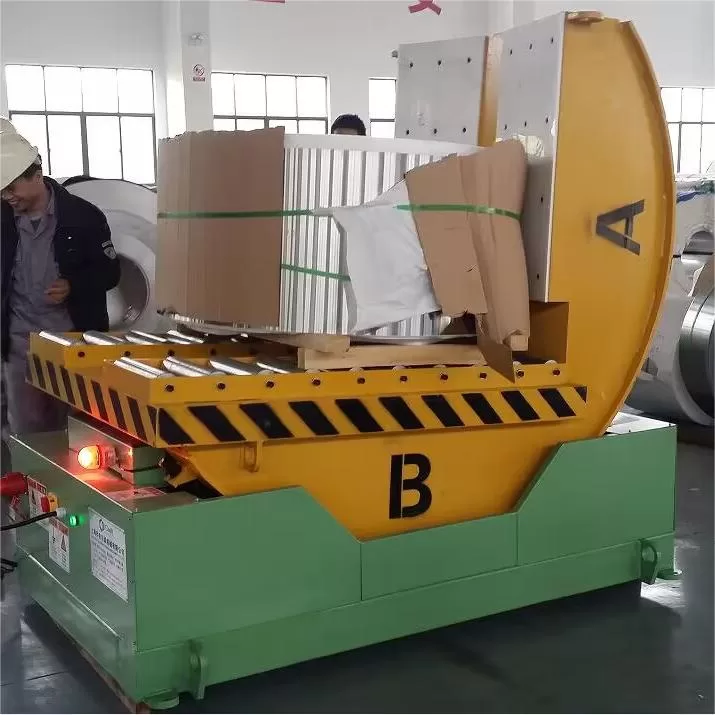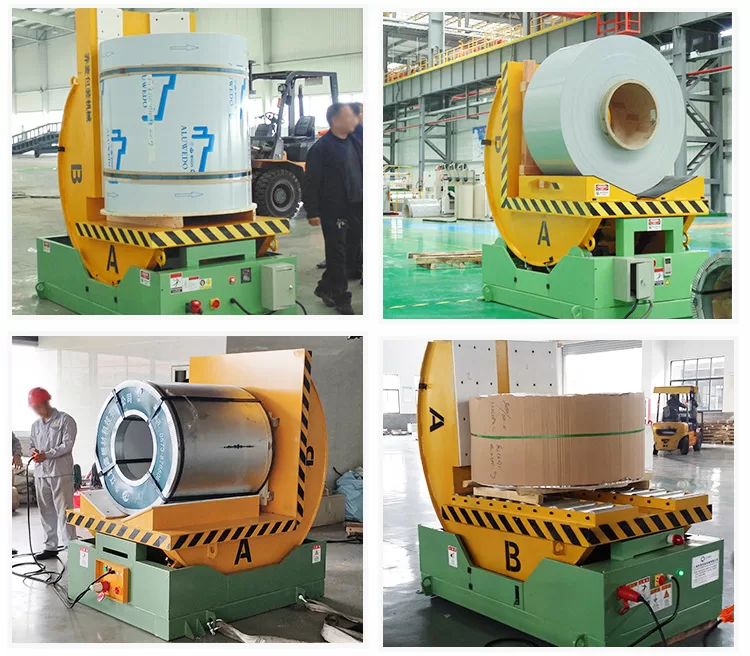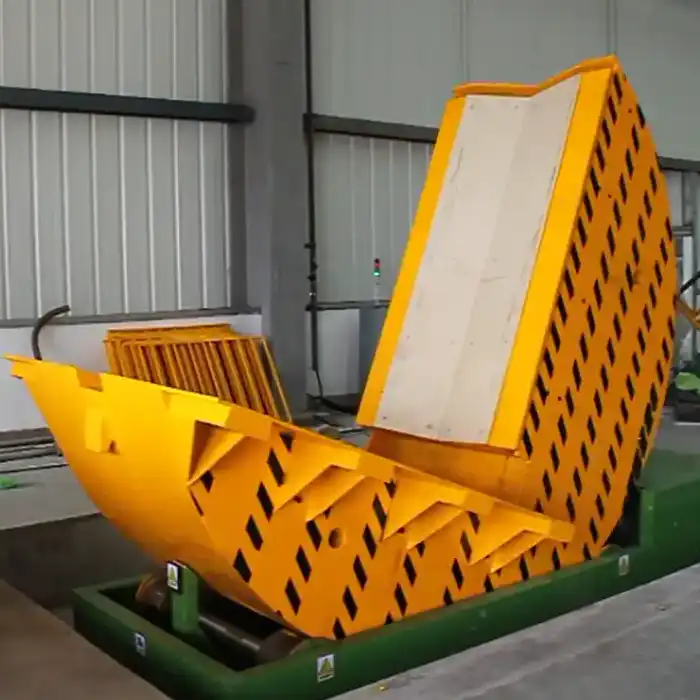Mechanical Coil Upender vs. Hydraulic Coil Tilter: Which Coil Handling Solution Best Fits Your Needs?

Choosing the right equipment for handling heavy steel or aluminum coils is crucial for operational efficiency, workplace safety, and long-term cost management. Two common solutions for rotating and repositioning these coils are the mechanical coil upender and the hydraulic coil tilter. While both perform the same fundamental task—changing the coil's orientation—they operate differently and offer distinct advantages depending on the application.
This article delves into the operational principles, benefits, and drawbacks of mechanical coil upenders and hydraulic coil tilters. By understanding these differences, you can make an informed decision about which coil handling equipment best suits your specific industrial requirements, whether your priority is speed, precision, maintenance, or budget.
1. Understanding Mechanical Coil Upenders
A mechanical coil upender utilizes an electromechanical system, typically involving electric motors, gearboxes, chains, or screw jacks, to physically lift and rotate a coil between horizontal and vertical positions. The drive system provides the force needed for rotation, ensuring consistent movement and operational reliability.
Key Characteristics:
- Drive System: Powered by electric motors driving gears, chains, or screw mechanisms.
- Operation: Provides robust and straightforward rotation.
- Common Industries: Steel processing, fabrication shops, stamping facilities, and anywhere durable, cost-effective coil rotation is needed.
Mechanical upenders are often favored in environments handling large, heavy coils where durability, simplicity, and cost-efficiency are paramount. Their relatively uncomplicated design translates to reliability and more straightforward maintenance routines compared to hydraulic alternatives.
2. Understanding Hydraulic Coil Tilters
A hydraulic coil tilter employs hydraulic cylinders, powered by a hydraulic power unit (HPU), to generate the force required to tilt or rotate a coil. This system allows for exceptionally smooth, controlled, and precise movements. The nature of hydraulics provides high force capabilities and even pressure distribution, making these tilters suitable for very heavy loads and delicate materials.
Key Characteristics:
- Drive System: Hydraulic cylinders powered by an HPU (motor, pump, reservoir, valves).
- Operation: Offers smooth, highly controlled, and adjustable tilting motion.
- Common Industries: Automotive manufacturing, aerospace, facilities handling sensitive or surface-critical materials, and applications requiring precise positioning.
Hydraulic coil tilters excel where precision, smooth handling, variable load capacity, and enhanced control are critical. While versatile, they typically involve a higher initial investment and more complex maintenance due to the nature of hydraulic systems (fluid, seals, filters, hoses).
3. Mechanical vs. Hydraulic: Key Differences Compared
While both systems rotate coils, their operational mechanics lead to significant differences in performance and suitability:
- Power Source & Force:
- Mechanical: Electromechanical drives (motors, gears). Consistent force delivery, well-suited for defined load ranges.
- Hydraulic: Hydraulic fluid pressure. Generally capable of higher force generation, providing smooth power for very heavy or variable loads.
- Control & Precision:
- Mechanical: Good control for standard rotation; less inherent fine-tuning capability during the motion.
- Hydraulic: Excellent control over speed and positioning; allows for gentle starts/stops and precise angle adjustments, ideal for delicate coils.
- Speed:
- Mechanical: Often designed for faster cycle times in high-throughput environments due to direct drive mechanisms.
- Hydraulic: Can be fast, but the emphasis is often on smooth, controlled movement, which might result in slightly slower cycle times compared to some mechanical designs.
- Maintenance & Durability:
- Mechanical: Generally simpler maintenance involving lubrication and checks on drive components (gears, chains). Fewer potential leak points. Often considered highly durable due to fewer complex parts.
- Hydraulic: Requires regular checks of hydraulic fluid levels and quality, filters, seals, hoses, and cylinders to prevent leaks and ensure performance. More complex system.
- Cost:
- Mechanical: Typically lower initial purchase price and potentially lower long-term maintenance costs due to simpler design.
- Hydraulic: Higher upfront investment due to the hydraulic power unit and precision components. Maintenance can also be more costly if leaks or component failures occur.
- Footprint & Installation:
A mechanical coil upender is often the optimal choice under the following circumstances:
- Budget Constraints: Lower initial investment is a primary factor.
- Standardized Loads: Handling coils of relatively consistent size and weight.
- High Throughput: Operations require fast, repetitive cycling.
- Durability Focus: The environment demands robust equipment that can withstand heavy use with simpler maintenance needs.
- Maintenance Simplicity: In-house maintenance teams are more familiar with mechanical systems.
- Less Need for Fine Control: Precise positioning or extremely gentle handling is not the top priority.
Consider a Mechanical Upender If: Your operation prioritizes speed, robustness, ease of maintenance, and cost-effectiveness for handling standard heavy coils.
5. When to Choose a Hydraulic Coil Tilter
A hydraulic coil tilter becomes the preferred solution when specific operational needs align with its strengths:
- Precision Handling Required: Dealing with delicate, surface-critical, or easily damaged coils (e.g., pre-painted metals, thin foils).
- Variable Load Handling: Facility processes coils of significantly different sizes and weights.
- Very Heavy Loads: Consistently handling coils at the upper end of weight capacities, where hydraulic power offers smooth control.
- Enhanced Safety Features Needed: Requirements for features like controlled acceleration/deceleration, overload protection, and precise stopping points. Adherence to strict safety protocols like those outlined by OSHA for material handling can be more easily integrated.
- Smooth Motion Critical: Minimizing any potential shock or vibration during rotation is essential.
- Budget Allows for Higher Investment: The benefits of precision and control justify the higher initial and potential maintenance costs.
Consider a Hydraulic Tilter If: Your operation demands precise control, smooth movement, flexibility for varied loads, or handles sensitive materials where preventing damage is paramount.
6. Evaluating Long-Term Investment and ROI
The choice between mechanical and hydraulic systems impacts your long-term return on investment (ROI):
- Mechanical Coil Upender ROI: Achieved through lower upfront cost, high durability, potentially lower maintenance expenses, and high operational uptime in demanding environments. Best ROI when throughput and reliability are key drivers.
- Hydraulic Coil Tilter ROI: Justified by enhanced precision (reducing material damage/scrap), flexibility (handling diverse products without multiple machines), potentially superior safety features (reducing accident risks), and ability to handle specialized tasks. Best ROI when product quality, flexibility, and controlled handling are critical.
7. Customization and Adaptability
Both systems can be customized, but their adaptability differs:
- Mechanical Upenders: Customization often involves specific platform sizes, cradle shapes (V-saddles, flat platforms), conveyor integration, and load capacities tailored to a defined range of coils. They are highly effective but potentially less flexible outside their designed parameters.
- Hydraulic Tilters: Offer inherent adaptability through adjustable speed, pressure settings, and precise angle control. Customization can include advanced controls, specialized cradles, integration with automated systems, and features for handling a broader spectrum of coil dimensions and weights.
If your operational needs frequently change or involve a wide variety of coil types, the hydraulic system generally offers greater inherent adaptability.

Conclusion: Making the Right Choice for Your Facility
Selecting the appropriate coil handling equipment—whether a mechanical coil upender or a hydraulic coil tilter—requires a careful assessment of your operational priorities.
- Choose a mechanical coil upender if your primary needs are cost-effectiveness, high-speed throughput, robustness, and simplified maintenance for relatively consistent coil types.
- Opt for a hydraulic coil tilter when precision handling, smooth motion, flexibility across various coil sizes/weights, handling delicate materials, or advanced control and safety features are critical, and the budget accommodates a higher initial investment.
By thoroughly analyzing your specific application requirements, budget, maintenance capabilities, and long-term goals against the distinct characteristics of each system, you can invest in the coil rotation solution that provides the best combination of performance, safety, and value for your manufacturing or processing facility.
